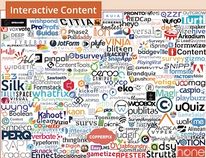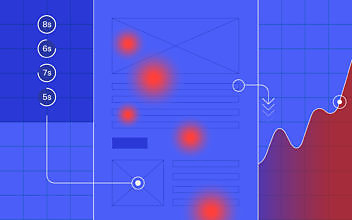Okay, this is going to seem obvious to a lot of you.
But stay with me. It’s actually a big deal in disguise.
At Velocity, we’re convinced that B2B marketers should be moving from content that’s consumed alone, off-screen and offline to content that’s consumed live, online and in full view of your sneaky little analytics bots.
In short, to do its job, content needs to be more like an app and less like a book.
Here at the Dawn of the Birth of the Emergence of the Era of the Data-Driven Revolution 3.0, content should be a live experience.
Content should be consumed in a session.
And that session should be instrumented, monitored and analyzed, on it’s own and as part of a larger journey (a journey we can only call a ‘buyer’s journey’ if it happens to be one of the few successful ones).
I hereby verbify this idea with the following, neologistic imperative:
Sessionize your content.
(Hey, the chance to invent a fresh, fugly piece of marketing jargon doesn’t come along every day.)
Sessionizing is a simple idea:
Content that’s downloaded might earn you a form fill (how 2000 of you) but it will deny you a far more valuable thing: insight into your target audience. What they like within your content, what they don’t, what keeps them reading or watching, what bores them silly, what makes them click away, what makes them come back…
That insight is worth it’s weight in golden pixels. And if you give up a form fill to get it (which, by the way, you don’t have to do), you’ve made a great deal.
We like to watch
Good marketers are voyeurs.
It’s not good enough to know that a prospect is ‘getting it on’ with a piece of our content. We like to watch. We need to watch.
Instead of just ticking a box that says Larry “read” (um, downloaded) an ebook—and awarding Larry 25 points in the lead scoring system—we need to watch Larry as he scans and scrolls and pauses and dwells and drills down… right up to the moment he clicks off to go somewhere else.
Why you should sessionize
Sessionizing your content properly tells you important things, like:
- Exactly how deeply each prospect engages with each piece of content
- How much time each spends with the whole piece and with each section of it.
- What options they choose on the way (if you gave them any options – see below)
- What they do after consuming. (Post-Prandial Progression)
And once you know this kind of thing for any given piece of content and any given prospect, you can start to learn things like:
- What topics resonate with what kind of prospect (by profile, industry, account, stage, past behavior…).
- What format and channel works best for whom.
- Where, within the piece, you lost people.
- What kind of things earned more engagement. Or less.
- Which content variables bring people back for more.
And once you know this, you can do powerful things like:
- Fix content that’s broken
- Target content better — or even personalize it.
- Continuously improve your engagement and conversion rates.
- Avoid all (previously invisible) inhibitors.
- Design integrated journeys instead of one-offs.
- Make your budget work harder.
- Impress people in meetings.
Okay, so those are some powerful reasons to turn your content into a session. Now the how:
How to sessionize your content
Four main steps:
- Digitize it.
Turn your content into a web page or mobile widget or interactive format. PDFs tell no tales. - Instrument it.
Build in sensors to generate really granular analytics about things like time on page, mouse moves, scrolls, dwells and clicks. - Invite interaction.
If you can, give people something to do other than consume. A quiz. A grader. An estimator or configurator. Or just some little buttons to let them drill down into a case story or a tech explainer. The more you ask of them, the more you learn. - Integrate it.
Pipe all that interaction and consumption data into your analytics platform, marketing automation profiles, personalization engine, lead scoring algorithm and attribution model.
Yes, your content can be a normal web page or blog post. But to turn it into a real session, you want granular analytics and a place to activate that data.
Time as the killer metric
Turning content into sessions opens up a metric that isn’t in the standard list of marketing metrics: time.
It may not be perfect, but time spent with your content is a great indicator of a prospect’s engagement and an account’s temperature.
More martech apps and platforms are starting to use time in just this way. Like PathFactory, the content insight and activation platform that turns all content into instrumented content tracks (disclosure: a Velocity client and friend). Also Engagio, marketing engagement software that tracks the time a given account spends with you (disclosure: same).
Dropouts: the cold slap in the face
One thing to prepare for when you start to sessionize your content: you’ll see things that upset you.
The main one for me is seeing dropout rates: the people who finish your content divided by the people who start it. Watching the data showing people fall away as a piece goes on will make you want either to cry, fire someone or fire someone, then cry.
Don’t do those things. Cheer up. Dropout was always a problem, you just couldn’t see it before. If you always thought of that PDF download as a person reading the whole ebook… well, that was vanity.
Being disillusioned may be no fun but it’s good for you: illusions lead to bad marketing.
Because—and this is the fun part—if you get to actually see where you lost people… you can fix it. We once saw a big drop-off on page 8 of a Velocity String (one of our first sessionized formats). We changed the copy from a ‘pause’ page to a ‘let’s dive in’ vibe… and the drop-off levels… dropped off.
That kind of in-flight course correction is only possible if you can watch people eat your content.
The dev factor
Making really good sessionized content usually involves a developer or two. That’s fine if you’re an award-winning B2B tech agency with a team of eight amazing developers just sitting around playing Sekiro: Shadows Die Twice.
But, as well as being grumpy, developers are expensive AF.
That’s why it’s a good idea to make big chunks of your sessionized content reusable. Our Strings, quizzes, graders, solution showcases, long-ass web pages and whole sites are built on using baseplates that separate out the presentation layer from the underlying logic. So you can produce a really slick piece of content with a lot less dev time.
Another approach is to use third-party content creation tools like the ones in this crowded little corner of the Martech Supergraphic:

There are some really good ones out there. Some, like Ceros, are so good, they won’t even talk to me (no hard feelings). Turtl looks really good too. (And PathFactory is certifiably awesome but you already know we have skin in that game).
By all means, try them out. The one thing I’d look for, though, is the ability to plumb the data from these tools into your analytics platform. You don’t want a data silo floating out there, hoarding its insight.
Same with video players: use one that shows you drop-off rates and completion scores — and lets you pump that data where you need it.
Do this.
So I hope I’ve convinced you to turn a lot more of your content into sessions so your bots can watch people as they consume it.
You don’t have to use the word “sessionize” if you don’t want to (the cool kids will). But I really do think you should do this.

Enjoyed this article?
Take part in the discussion








Comments
There are no comments yet for this post. Why not be the first?